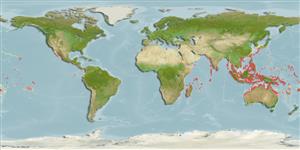Common names from other countries
Environment: milieu / climate zone / depth range / distribution range
Ecologia
marinhas associadas(os) a recifes; intervalo de profundidade 1 - 15 m (Ref. 86942). Tropical
Indo-West Pacific: Sri Lanka to Fiji (Ref. 9710) and Tonga (Ref. 53797), north to Taiwan, south to northern Australia.
Tamanho / Peso / Idade
Maturity: Lm ? range ? - ? cm
Max length : 12.0 cm TL macho/indeterminado; (Ref. 2272)
Espinhos dorsais (total): 9; Raios dorsais moles (total): 11-12; Espinhos anais 3; Raios anais moles: 11 - 12; Vértebras: 25. Young green when in seagrasses and greenish brown on reefs. Recognized by the unusual color patterns on the cheek or the black spotted scales over the back (Ref. 48636). Preserved male specimens with pale spots on scales; dark spot behind eye (continuous with a bifurcating dark band which extends ventrally); another on opercle; a dark band on snout from upper lip to eye; head with bands; spot on upper caudal base may be present or absent (present in females). Anterior lateral line scales with 1-3 pores (usually 2); 5-6 suborbital pores. Anterior dorsal and anal soft rays longer than posterior rays; pelvic fins of males relatively short, not reaching anus.
Found usually in groups (Ref. 90102) in shallow coastal reefs and seagrass flats (Ref. 9710), also in algae-rocky reef flats and lagoons (Ref. 48636).
Life cycle and mating behavior
Maturidade | Reprodução | Desova | Ovos | Fecundidade | Larvas
Randall, J.E., 1980. Two new Indo-Pacific labrid fishes of the genus Halichoeres, with notes on other species of the genus. Pac. Sci. 34(4):415-432. (Ref. 2136)
Categoria na Lista Vermelha da IUCN (Ref. 130435)
CITES (Ref. 128078)
Not Evaluated
Ameaça para o homem
Harmless
Utilização humana
Pescarias: pouco comercial; Aquário: Espécies comerciais
Mais informação
Nomes comunsSinónimosMetabolismoPredadoresEcotoxicologiaReproduçãoMaturidadeDesovaFecundidadeOvosDesenvolvimento dos ovos
ReferênciasAquaculturaPerfil para aquaculturaEstirpesGenéticaElectrophoresesHereditariedadeDoençasProcessamentoMass conversion
ColaboradoresFotografiasStamps, Coins Misc.SonsCiguateraVelocidadeTipo de nataçãoÁrea branquialOutras referênciasCérebrosVisão
Ferramentas
Relatórios especiais
Descarregue XML
Fontes da internet
Estimates based on models
Preferred temperature (Ref.
115969): 25.1 - 29.3, mean 28.5 (based on 2913 cells).
Phylogenetic diversity index (Ref.
82804): PD
50 = 0.5000 [Uniqueness, from 0.5 = low to 2.0 = high].
Bayesian length-weight: a=0.00813 (0.00473 - 0.01397), b=3.05 (2.90 - 3.20), in cm Total Length, based on LWR estimates for this species & Genus-body shape (Ref.
93245).
Nível Trófico (Ref.
69278): 3.4 ±0.5 se; based on size and trophs of closest relatives
Resiliência (Ref.
120179): Elevada, tempo mínimo de duplicação da população menor que 15 meses (Preliminary K or Fecundity.).
Fishing Vulnerability (Ref.
59153): Low vulnerability (10 of 100).
